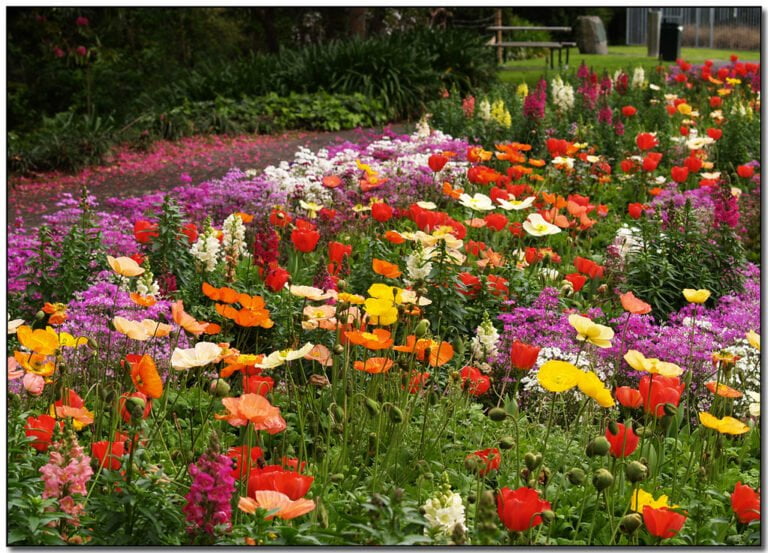Understanding the Causes and Solutions for Dead Snapdragons
I’ve found that dead snapdragons are often due to overwatering and soil waterlogging. These conditions can lead to root rot, causing the plant to wither away. To save them, adjust watering habits, ensuring the soil isn’t too wet. Wilting may also signal dehydration or diseases like downy mildew. Proper drainage and disease prevention are key in reviving them. More insight on signs of wilting, disease impact, watering importance, and drainage strategies can further help you protect your snapdragons and nurture them back to health.
Common Causes of Dead Snapdragons
Overwatering leads to root rot and snapdragon death. When soil becomes waterlogged due to excessive watering or poor drainage, it creates an optimal environment for root rot pathogens like Pythium and Rhizoctonia to thrive. These fungi attack the roots, causing them to deteriorate and lose their ability to absorb nutrients and water effectively. Consequently, the snapdragon plant is unable to sustain itself and eventually perishes.
In addition to root rot, infected leaves can also contribute to the decline of snapdragons. Diseases like downy mildew can lead to wilting and yellowing of leaves, depriving the plant of essential photosynthesis processes. Without the capacity to produce food, the snapdragon weakens and becomes more vulnerable to other stressors, hastening its demise.
To prevent root rot and leaf infections, it is vital to avoid overwatering and ensure proper soil drainage. By allowing the soil to dry out slightly between waterings and providing adequate drainage, you can help maintain a healthy root system and reduce the risk of fungal diseases. Regularly inspecting the leaves for signs of infection and promptly addressing any issues that arise can also help prolong the life of your snapdragons.
Signs of Wilting in Snapdragons
Wilting in snapdragons manifests as drooping stems and leaves lacking turgor pressure, often accompanied by yellowing or browning due to moisture stress or disease. This visible sign of wilting indicates that the plant is not receiving sufficient water to maintain its turgidity. When snapdragons experience insufficient water intake, their cells lose water, resulting in a loss of pressure within the plant tissues. As a consequence, the stems and leaves lose their rigidity, causing them to droop and appear limp.
In snapdragons, wilting can be a direct result of dehydration caused by inadequate water supply. Insufficient water intake can lead to a decrease in the plant’s ability to support its structure, resulting in the characteristic drooping of stems and leaves. Additionally, diseases such as Verticillium wilt can also contribute to wilting in snapdragons by affecting the plant’s vascular system, hindering the proper transportation of water and nutrients.
To address wilting in snapdragons, it is vital to make sure that the plants receive an adequate amount of water to maintain turgor pressure within their cells. Monitoring soil moisture levels and providing regular watering can help prevent wilting due to insufficient water intake. Additionally, implementing proper disease prevention strategies and maintaining overall soil health are important steps in safeguarding snapdragons from wilting episodes.
Impact of Disease on Snapdragons
Diseases like anthracnose, botrytis blight, and powdery mildew can severely impact snapdragons, causing symptoms such as yellow spots, stunted growth, and fungal growth on petals. To prevent disease in snapdragons, strategies like maintaining good air circulation, reducing humidity, and applying fungicides can be effective. Proper sanitation practices, spacing for air circulation, and the use of recommended fungicides are vital for protecting snapdragons from disease-related issues.
Disease Effects on Snapdragons
Anthracnose and Botrytis blight are common diseases that greatly impact the health and appearance of snapdragons, manifesting through distinct symptoms on the leaves and petals. Anthracnose causes yellow spots on lower leaves, with stem death if girdled by Colletotrichum antirrhini. On the other hand, Botrytis blight leads to brown petals with gray fungal growth, caused by Botrytis cinerea, necessitating good air circulation for prevention. These diseases highlight the importance of maintaining ideal growing conditions, such as avoiding overcrowding to promote good air circulation. Early detection and proper management are essential to prevent these diseases from spreading and causing irreparable damage to snapdragon plants.
Preventing Disease in Snapdragons
Fungal pathogens like Colletotrichum antirrhini and Botrytis cinerea pose significant risks to snapdragons, potentially leading to plant death if left unmanaged. To prevent disease spread, promptly remove and destroy infected plants to prevent spore dispersal. Implement proper sanitation practices by disinfecting tools and containers to minimize pathogen transmission. Improve air circulation around snapdragons to reduce humidity levels, creating an unfavorable environment for fungal growth. Consider fungicide application following manufacturer recommendations to control diseases effectively. Monitor snapdragons regularly for signs of infection such as leaf spots or stem rot. Rust caused by Puccinia antirrhini can also impact snapdragons, so vigilance is crucial. By integrating these practices, snapdragons can be safeguarded from disease damage, ensuring their health and vitality.
Importance of Proper Watering
When tending to snapdragons, ensuring correct watering practices is essential for their overall health and longevity. Snapdragons require consistently moist, well-drained soil to thrive. Overwatering can lead to root rot and wilting, while underwatering can result in dehydration and eventual plant death. To maintain ideal soil moisture levels, it is vital to monitor the plant’s watering needs regularly.
Watering snapdragons at the base of the plant in the morning is recommended. This practice allows the foliage to dry during the day, reducing the risk of fungal diseases that thrive in moist environments. By watering at the base, you can deliver water directly to the roots where it is needed most, promoting healthy growth and development.
Adjusting the frequency of watering based on weather conditions and the individual needs of the snapdragons is key to their well-being. During hot and dry periods, more frequent watering may be necessary to prevent dehydration. In contrast, during cooler and wetter seasons, reducing the amount of water can help prevent waterlogging and related issues.
Strategies for Improving Drainage
Enhancing drainage in snapdragon planting areas is essential for preventing waterlogged conditions that can lead to root rot. Proper drainage facilitates excess water removal to reduce the risk of water stress. Improving soil structure through mulching or incorporating drainage materials like peat moss can boost drainage efficiency.
Soil Moisture Management
To improve the drainage of soil for snapdragons, integrating organic matter is a vital step for preventing waterlogging and encouraging ideal water infiltration. Good soil moisture management is key to maintaining healthy snapdragons. Avoid watering excessively, as it can lead to root rot and plant demise. By incorporating organic matter into the soil, you can create air pockets that improve drainage and prevent water from pooling around the roots, promoting ideal growing conditions. Monitoring soil moisture levels regularly is essential to guarantee snapdragons receive adequate water without being overwatered. This proactive approach helps prevent wilting and guarantees that snapdragons thrive without succumbing to the negative effects of water stress.
Mulching for Drainage
Mulching plays an important role in enhancing soil structure and promoting better drainage for snapdragons. By increasing the organic matter content in the soil, mulch helps to improve drainage conditions. Organic mulches such as bark, wood chips, or straw are particularly effective in heavy clay soils, as they reduce compaction, allowing for improved water infiltration and root growth. Additionally, mulch acts as a barrier that prevents water runoff and erosion, especially during periods of heavy rainfall. This process not only regulates soil temperature but also reduces water stress on plants, fostering healthy root development. Therefore, incorporating proper mulching techniques is essential for maintaining ideal drainage levels, which are crucial for the overall health and vitality of snapdragons.
Implementing Soil Sterilization Techniques
Implementing soil sterilization techniques is vital for creating a disease-free environment that promotes ideal growth conditions for snapdragons. Soil sterilization involves treating the soil to eliminate harmful pathogens, pests, and weed seeds that can negatively impact plant health. Common methods for soil sterilization include steam sterilization, chemical sterilization, and solarization.
By properly sterilizing the soil before planting snapdragons, we can greatly reduce the risk of diseases such as root rot, damping-off, and other soil-borne infections. These diseases can lead to sudden plant death and hinder the overall health and growth of snapdragons. Therefore, incorporating soil sterilization techniques is essential for maintaining a healthy growing environment for these plants.
Effective soil sterilization techniques not only eliminate potential threats to plant health but also create a clean slate for ideal root development and nutrient uptake. This process sets the stage for robust growth and vibrant blooms in snapdragons. By taking proactive measures to sterilize the soil, we can guarantee that snapdragons have the best possible conditions to thrive and flourish.
Prompt Actions to Save Wilting Snapdragons
When rescuing wilting snapdragons, vital intervention is imperative to prevent further deterioration. Wilting in snapdragons can be indicative of various issues, including water stress from improper watering. To address wilting effectively, proper watering practices must be followed. Snapdragons require consistent moisture levels in the soil to thrive, but overwatering can lead to root rot, while underwatering causes wilting and dehydration.
To save wilting snapdragons, the first step is to assess the soil moisture levels. If the soil is dry to the touch, immediate watering is necessary. However, be cautious not to saturate the soil excessively. It is advisable to water deeply but infrequently to encourage deep root growth and prevent waterlogging.
Additionally, inspect the snapdragons for signs of diseases like downy mildew or root rot, which can contribute to wilting. If any diseased plant material is identified, promptly remove it to prevent the spread of infection.
Proper drainage is also critical in preventing wilting. Make sure that the soil has adequate drainage to avoid water accumulation around the roots, which can lead to suffocation and wilting.






